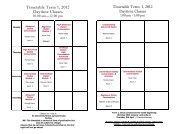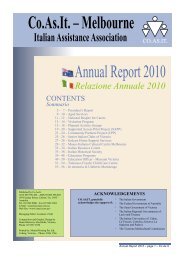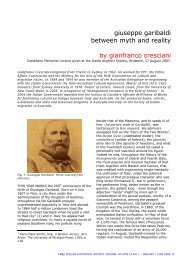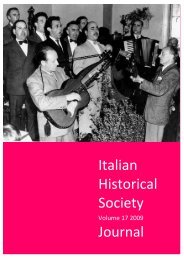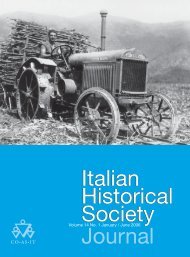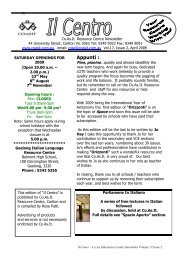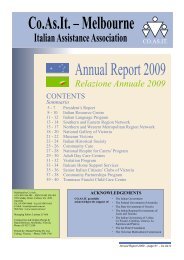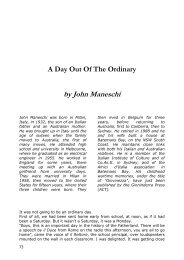signs of italian culture in the urban landscape of carlton
signs of italian culture in the urban landscape of carlton
signs of italian culture in the urban landscape of carlton
You also want an ePaper? Increase the reach of your titles
YUMPU automatically turns print PDFs into web optimized ePapers that Google loves.
2<br />
<strong>signs</strong> <strong>of</strong> <strong>italian</strong> <strong>culture</strong> <strong>in</strong> <strong>the</strong><br />
<strong>urban</strong> <strong>landscape</strong> <strong>of</strong> <strong>carlton</strong><br />
by<br />
ALICE GIULIA DAL BORGO<br />
ITALIAN<br />
HISTORICAL<br />
SOCIETY<br />
JOURNAL<br />
THIS IS PART TWO OF A RESEARCH<br />
PROJECT CONDUCTED BY THE AUTHOR<br />
IN MELBOURNE IN 2004 IN ASSOCIATION<br />
WITH THE INSTITUTE OF HUMAN<br />
GEOGRAPHY OF THE UNIVERSITY OF<br />
MILAN AND WITH THE ASSISTANCE OF<br />
THE ITALIAN AUSTRALIAN INSTITUTE<br />
(IAI) IN MELBOURNE. THE PROJECT WAS<br />
SUPPORTED BY A SCHOLARSHIP FROM<br />
THE EUROPEAN UNION’S MARCO POLO<br />
PROGRAMME. IN CONDUCTING HER<br />
RESEARCH, DAL BORGO DREW HEAVILY<br />
ON RECORDS FROM THE ITALIAN<br />
HISTORICAL SOCIETY COLLECTION<br />
AND ON KEY SOURCES INCLUDING<br />
SAGAZIO’S ‘A WALK THROUGH ITALIAN<br />
CARLTON’ (1988) AND ‘YULE’S CARLTON:<br />
A HISTORY’ (2004).<br />
IN 2001, DAL BORGO OBTAINED A<br />
DEGREE FROM THE FACULTY OF ARTS<br />
AND PHILOSOPHY, MILAN UNIVERSITY,<br />
MAJORING IN ENVIRONMENTAL<br />
GEOGRAPHY. HER THESIS, ‘CULTURAL<br />
GEOGRAPHY OF THE CIMBRI ENCLAVES<br />
IN ITALY,’ WAS PUBLISHED IN 2004.<br />
IN 2002, SHE OBTAINED A MASTERS IN<br />
MANAGEMENT OF THE ENVIRONMENT<br />
AND OF THE LANDSCAPE: KNOWLEDGE,<br />
COMMUNICATION AND ACTION FROM<br />
THE INSTITUTE OF HUMAN GEOGRAPHY,<br />
MILAN UNIVERSITY. SHE IS NOW<br />
UNDERTAKING A PHD IN ENVIRONMENTAL<br />
QUALITY AND ECONOMIC REGIONAL<br />
DEVELOPMENT AT THE UNIVERSITY OF<br />
BOLOGNA IN ASSOCIATION WITH THE<br />
MILAN UNIVERSITY. DAL BORGO IS A<br />
TUTOR AT THE DEPARTMENT OF ARTS<br />
AND PHILOSOPHY OF MILAN UNIVERSITY.<br />
To understand what Carlton means to <strong>the</strong><br />
Italians <strong>of</strong> Melbourne,<br />
one must have experience with emigration;<br />
have suffered <strong>the</strong> solitude,<br />
<strong>the</strong> lack <strong>of</strong> understand<strong>in</strong>g and at times,<br />
disda<strong>in</strong>;<br />
to arrive <strong>in</strong> a place and feel completely lost.<br />
To feel like a nobody.<br />
Carlton has been <strong>the</strong> cradle <strong>of</strong> our<br />
migration to Melbourne;<br />
<strong>the</strong> ga<strong>the</strong>r<strong>in</strong>g place for those arriv<strong>in</strong>g<br />
migrants who knew that someone,<br />
somewhere, was wait<strong>in</strong>g for <strong>the</strong>m,<br />
that some voice was speak<strong>in</strong>g <strong>the</strong> same<br />
language. 1<br />
The area known today as Carlton, a<br />
suburb at <strong>the</strong> nor<strong>the</strong>rn edge <strong>of</strong> <strong>the</strong> city <strong>of</strong><br />
Melbourne, was orig<strong>in</strong>ally <strong>in</strong>habited by<br />
<strong>the</strong> Wurundjeri people, members <strong>of</strong> <strong>the</strong><br />
Woiwurrung language group. European<br />
settlement caused irreversible damage to<br />
<strong>the</strong> ecosystem on which <strong>the</strong> Wurundjeri<br />
depended as well as to <strong>the</strong>ir social and<br />
cultural systems. The colonists claimed<br />
Wurundjeri lands for graz<strong>in</strong>g, forc<strong>in</strong>g <strong>the</strong><br />
traditional owners <strong>in</strong>to areas populated<br />
by o<strong>the</strong>r clans and <strong>in</strong>to conflict with <strong>the</strong>se<br />
communities. Such was <strong>the</strong> feel<strong>in</strong>g <strong>of</strong><br />
hopelessness and displacement between<br />
<strong>the</strong> 1840s and 1850s that Wurundjeri<br />
parents practiced <strong>in</strong>fanticide. A last<br />
va<strong>in</strong> attempt to rega<strong>in</strong> <strong>the</strong> land taken by<br />
Europeans was met with gunfire. The<br />
<strong>in</strong>digenous community was fur<strong>the</strong>r ravaged<br />
by <strong>in</strong>fectious diseases, such as smallpox,<br />
<strong>in</strong>fluenza and venereal diseases <strong>in</strong>troduced<br />
by <strong>the</strong> colonisers. By <strong>the</strong> end <strong>of</strong> 1850, <strong>the</strong><br />
rema<strong>in</strong>s <strong>of</strong> <strong>the</strong> Wurundjeri community had<br />
retreated to a small pocket <strong>of</strong> land to <strong>the</strong><br />
north <strong>of</strong> <strong>the</strong> city. In 1863, by government<br />
edict, this group was relocated to a<br />
property near Healesville.<br />
The history <strong>of</strong> Carlton is <strong>in</strong>explicably tied to<br />
<strong>the</strong> gold rush and <strong>the</strong> <strong>in</strong>creas<strong>in</strong>g number<br />
<strong>of</strong> immigrants seek<strong>in</strong>g accommodation<br />
<strong>in</strong> <strong>the</strong> City <strong>of</strong> Melbourne. Carlton first<br />
appears on a map <strong>in</strong> <strong>the</strong> early 1850s as a<br />
city extension 2 , drawn by General Robert<br />
Hoddle as a rectangular grid not unlike that<br />
<strong>of</strong> <strong>the</strong> city centre. Although a proposal to<br />
create a suburb called Carlton was tabled<br />
<strong>in</strong> <strong>the</strong> Victorian government gazette <strong>of</strong> 1852<br />
and <strong>the</strong> sale <strong>of</strong> plots <strong>of</strong> land began <strong>in</strong> <strong>the</strong><br />
same year, <strong>the</strong> area cont<strong>in</strong>ued to be known<br />
as North Melbourne. In <strong>the</strong> two decades<br />
that followed, <strong>the</strong> suburb was transformed<br />
by a comb<strong>in</strong>ation <strong>of</strong> planned and, at its<br />
far<strong>the</strong>st reaches, unregulated build<strong>in</strong>g.<br />
Historians dispute <strong>the</strong> orig<strong>in</strong>s <strong>of</strong> <strong>the</strong> name<br />
Carlton; what is known is that by <strong>the</strong> 1870s<br />
<strong>the</strong> suburb had taken on <strong>the</strong> boundaries<br />
which identify it today.<br />
From <strong>the</strong> 1850s to around 1880, wealthy<br />
developers bought pockets <strong>of</strong> land <strong>in</strong><br />
Carlton on which <strong>the</strong>y constructed homes<br />
and factories <strong>in</strong> bluestone, brick and wood.<br />
Dur<strong>in</strong>g this time, <strong>the</strong> first <strong>of</strong> <strong>the</strong> suburb’s<br />
characteristic Victorian terrace houses<br />
appeared. Throughout <strong>the</strong> n<strong>in</strong>eteenth<br />
century ‘reverence for Italy and symbols <strong>of</strong><br />
Italian <strong>culture</strong> was reflected <strong>in</strong> <strong>the</strong> attitudes<br />
<strong>of</strong> middle and upper class Australians and<br />
<strong>in</strong> <strong>the</strong>ir fondness for buy<strong>in</strong>g Italian goods<br />
and emulat<strong>in</strong>g Italian cultural styles’. 3 The<br />
bourgeoisie learnt Italian and merchants<br />
and farmers built <strong>the</strong>ir residences <strong>in</strong> <strong>the</strong><br />
‘Italian-style’, decorat<strong>in</strong>g <strong>the</strong>m with Italian<br />
statues, marble and furniture.
SIGNS OF ITALIAN CULTURE IN THE URBAN LANDSCAPE OF CARLTON<br />
Alongside major traffic <strong>in</strong>tersections was a<br />
network <strong>of</strong> secondary streets and lanes and<br />
it was here that unregulated build<strong>in</strong>g saw<br />
<strong>the</strong> speedy construction <strong>of</strong> densely packed<br />
dwell<strong>in</strong>gs amid poor sanitary conditions.<br />
These were <strong>the</strong> so-called slum pockets<br />
which would be earmarked for demolition<br />
<strong>in</strong> <strong>the</strong> 1930s. By <strong>the</strong> end <strong>of</strong> World War II,<br />
Carlton’s demographic makeup consisted<br />
ma<strong>in</strong>ly <strong>of</strong> large work<strong>in</strong>g class families liv<strong>in</strong>g<br />
<strong>in</strong> rented Victorian and Edwardian cottages.<br />
From its early days, Carlton has been a<br />
neighbourhood <strong>of</strong> new arrivals: Jews,<br />
Italians, Greeks, Lebanese and latterly<br />
Ethiopians have made it <strong>the</strong>ir first port <strong>of</strong><br />
call, mark<strong>in</strong>g <strong>the</strong>ir passage through Carlton<br />
with <strong>the</strong>ir own <strong>in</strong>delible style. Accord<strong>in</strong>g<br />
to historian Celest<strong>in</strong>a Sagazio, <strong>the</strong> Italian<br />
community established itself <strong>in</strong> Carlton <strong>in</strong><br />
three successive waves: <strong>the</strong> first phase<br />
occurred between <strong>the</strong> second half <strong>of</strong> <strong>the</strong><br />
n<strong>in</strong>eteenth century and World War I, <strong>the</strong><br />
second between <strong>the</strong> two World Wars and<br />
<strong>the</strong> third after World War II. The earliest<br />
arrivals were musicians from Basilicata<br />
<strong>in</strong> <strong>the</strong> south <strong>of</strong> Italy, followed by friuliani,<br />
trevisani and vicent<strong>in</strong>i from <strong>the</strong> north. The<br />
first arrivals settled <strong>in</strong> <strong>the</strong> heart <strong>of</strong> Carlton<br />
and to <strong>the</strong> south, while those who arrived<br />
after World War II, from Sicily, Calabria<br />
and Abruzzo, chose <strong>the</strong> north <strong>of</strong> Carlton.<br />
Toge<strong>the</strong>r, <strong>the</strong>se migrants formed <strong>the</strong> Italian<br />
community. Dur<strong>in</strong>g <strong>the</strong> 1950s, <strong>the</strong> Jewish<br />
population began to leave Carlton for o<strong>the</strong>r<br />
suburbs. These are <strong>the</strong> years when Italian<br />
settlement was at its most conspicuous:<br />
‘In <strong>the</strong> 1950s and 1960s, Carlton became<br />
<strong>the</strong> first and best known “Little Italy”<br />
<strong>in</strong> Australia. It was <strong>in</strong> many ways <strong>the</strong><br />
Italians’ home away from home. Some<br />
historians argue that by 1960 <strong>the</strong> various<br />
groups <strong>of</strong> Italian migrants had formed<br />
an Italo-Australian community. The<br />
concept <strong>of</strong> community was widely used<br />
by Italian newspapers, political leaders<br />
and by <strong>the</strong> public. The term embraced<br />
all people <strong>of</strong> Italian descent liv<strong>in</strong>g <strong>in</strong><br />
Australia. It assumed that <strong>the</strong>y had more<br />
<strong>in</strong> common with each o<strong>the</strong>r than with o<strong>the</strong>r<br />
Australians’. 4<br />
At this po<strong>in</strong>t one may ask why Carlton was<br />
<strong>the</strong> first port <strong>of</strong> call for many migrants. The<br />
majority <strong>of</strong> Italians migrat<strong>in</strong>g to Australia, as<br />
well as to o<strong>the</strong>r parts <strong>of</strong> <strong>the</strong> globe, did not<br />
arrive under <strong>the</strong> Australian government’s<br />
Assisted Passage Scheme. Instead,<br />
<strong>the</strong>y paid <strong>the</strong>ir own way, gravitat<strong>in</strong>g to<br />
those areas where o<strong>the</strong>r Italian migrants,<br />
sometimes from <strong>the</strong> same town, had<br />
already established <strong>the</strong>mselves. These<br />
established paesani helped new arrivals<br />
to f<strong>in</strong>d work and accommodation. Cha<strong>in</strong><br />
migration, hostility from <strong>the</strong> Anglo-<br />
Australian community, proximity to<br />
employment and <strong>the</strong> lack <strong>of</strong> assistance<br />
from <strong>the</strong> Australian government were all<br />
factors which guided <strong>the</strong> Italian migrant to<br />
Carlton.<br />
Initially, <strong>the</strong> majority <strong>of</strong> Italian migrants were<br />
male. Those from <strong>the</strong> north <strong>of</strong> Italy found<br />
employment <strong>in</strong> <strong>the</strong> construction <strong>in</strong>dustry,<br />
while sou<strong>the</strong>rners worked <strong>in</strong> sub<strong>urban</strong><br />
factories, market gardens or <strong>in</strong> <strong>the</strong><br />
hospital and clean<strong>in</strong>g sectors. Many were<br />
musicians, grocers, fruit and vegetable<br />
merchants, barbers, restaurateurs and<br />
bakers. Migrants from Friuli and Veneto<br />
were experts <strong>in</strong> terrazzo mak<strong>in</strong>g as well as<br />
bricklay<strong>in</strong>g and carpentry. Italian women<br />
<strong>in</strong> <strong>the</strong> ma<strong>in</strong> worked from home, tak<strong>in</strong>g <strong>in</strong><br />
sew<strong>in</strong>g or runn<strong>in</strong>g board<strong>in</strong>g houses for<br />
newly arrived migrants. From <strong>the</strong> 1950s<br />
onward, many Italian women also found<br />
work <strong>in</strong> <strong>the</strong> cloth<strong>in</strong>g and textile <strong>in</strong>dustry.<br />
In 1891, Italians represented 1% <strong>of</strong> <strong>the</strong><br />
population <strong>of</strong> metropolitan Melbourne and<br />
even by 1914 <strong>the</strong>ir numbers did not exceed<br />
100. However, between 1921 and 1947<br />
<strong>the</strong> Italian population rose dramatically<br />
from 237 to 1,612, and <strong>in</strong> June 1960 <strong>the</strong><br />
number soared to 5,000 or 20% <strong>of</strong> <strong>the</strong> total<br />
population <strong>of</strong> Carlton. Although <strong>the</strong>se are<br />
approximate figures for <strong>the</strong> municipality<br />
as a whole, <strong>the</strong>y <strong>in</strong>dicate a grow<strong>in</strong>g Italian<br />
presence <strong>in</strong> <strong>the</strong> area. As affirmed by<br />
demographer F Lancaster Jones:<br />
‘In 1945 only 14 shops <strong>in</strong> Lygon Street<br />
between Queensberry and Elg<strong>in</strong> Streets<br />
had Italian proprietors [….]. The 1960<br />
Melbourne directory lists 47 Italian<br />
shops <strong>in</strong> <strong>the</strong> same area, <strong>in</strong>clud<strong>in</strong>g n<strong>in</strong>e<br />
espresso bars, three hairdressers, three<br />
butchers, two electrical goods retailers,<br />
two photographers, two estate agents,<br />
a chemist, a florist, a motor mechanic, a<br />
large emporium, and even an Italian hotel<br />
proprietor. Elsewhere <strong>in</strong> <strong>the</strong> Carlton area, an<br />
Italian priest, Italian doctors and solicitors,<br />
and a multitude <strong>of</strong> Italian tradesmen<br />
completed what is for many Melbourne’s<br />
Italians a home away form home. For by<br />
<strong>the</strong> middle <strong>of</strong> 1960 at least one-quarter <strong>of</strong><br />
Carlton’s population was <strong>of</strong> Italian orig<strong>in</strong>’. 5<br />
Until 1971, <strong>the</strong> Italian-born population<br />
<strong>of</strong> North Carlton was 28.5%. Today, this<br />
percentage has dropped to 4%. From <strong>the</strong><br />
end <strong>of</strong> <strong>the</strong> 1960s, Carlton Italians moved to<br />
<strong>the</strong> outer suburbs where <strong>the</strong>y built spacious<br />
houses on larger blocks. None<strong>the</strong>less,<br />
ITALIAN<br />
HISTORICAL<br />
SOCIETY<br />
JOURNAL 3
SIGNS OF ITALIAN CULTURE IN THE URBAN LANDSCAPE OF CARLTON<br />
FIG 1: Edwardian home [left] and<br />
an example <strong>of</strong> Italian migrant<br />
architecture [right]. 496-500<br />
Rathdowne Street, North Carlton,<br />
Victoria. September 2004.<br />
FIG 2: Victorian façade [right],<br />
and an example <strong>of</strong> <strong>the</strong> “Mediterranean”<br />
style [left]. 75 Lee Street,<br />
North Carlton, Victoria. September<br />
2004.<br />
FIG 3: An example <strong>of</strong> a squared<br />
<strong>of</strong>f façade [right]. 635 and 637<br />
Lygon Street, Carlton, Victoria.<br />
September 2004.<br />
FIG 4: An example <strong>of</strong> porch<br />
pav<strong>in</strong>g. 195 Palmerston Street,<br />
Carlton, Victoria.<br />
September 2004.<br />
<strong>the</strong> sense <strong>of</strong> community and village life<br />
created by Carlton’s Italian community is<br />
still evident to both visitors and residents <strong>of</strong><br />
Carlton. 6<br />
ARCHITECTURE:<br />
THE CHANGES MADE BY ITALIANS<br />
From <strong>the</strong> 1950s to <strong>the</strong> 1960s, newly<br />
arrived Italian migrants generally found<br />
accommodation <strong>in</strong> one <strong>of</strong> Carlton’s many<br />
board<strong>in</strong>g houses run by fellow migrants.<br />
A modest fee covered <strong>the</strong> cost <strong>of</strong> a room<br />
(usually shared with o<strong>the</strong>rs) and a hot<br />
meal. Lack <strong>of</strong> privacy and long work<strong>in</strong>g<br />
hours were among <strong>the</strong> sacrifices migrants<br />
made <strong>in</strong> order to buy, <strong>in</strong> a relatively short<br />
time, <strong>the</strong>ir own home. Own<strong>in</strong>g a home<br />
facilitated <strong>the</strong> process <strong>of</strong> sistemazione<br />
or settl<strong>in</strong>g down and enabled migrants<br />
to ga<strong>in</strong> a sense <strong>of</strong> ‘… place and a sense<br />
<strong>of</strong> belong<strong>in</strong>g <strong>in</strong> Australia… a sense <strong>of</strong><br />
citizenship’. 7<br />
The majority <strong>of</strong> homes purchased by<br />
Italian migrants were terraces and small<br />
Victorian and Edwardian-style cottages,<br />
<strong>of</strong>ten run-down or <strong>in</strong> ru<strong>in</strong>, which were <strong>the</strong>n<br />
renovated <strong>in</strong> what came to be known as <strong>the</strong><br />
‘Mediterranean style’. [Fig.1&2]<br />
‘There is an Australia-wide post-World<br />
War II immigrant architectural tradition,<br />
which (while be<strong>in</strong>g regionally diverse<br />
and sometimes <strong>the</strong> subject <strong>of</strong> unjustified<br />
derision) is an identifiable idiom <strong>in</strong> <strong>the</strong><br />
history <strong>of</strong> Australian architecture’. 8 Typically,<br />
FIG 1<br />
FIG 2<br />
<strong>the</strong> exterior walls were plastered <strong>in</strong> green<br />
or p<strong>in</strong>k, a practice which recalled domestic<br />
architecture <strong>in</strong> <strong>the</strong> land <strong>of</strong> orig<strong>in</strong>. Façades<br />
were squared <strong>of</strong>f [Fig.3], porches were<br />
repaved with tiles that <strong>in</strong> Italy were used<br />
for pav<strong>in</strong>g sunro<strong>of</strong>s [Fig.4], wrought-iron<br />
friezes were removed from <strong>the</strong> front porch<br />
[Fig.5] and picket or wrought-iron fences<br />
were replaced with rendered concrete<br />
or exposed bricks [Fig.6]. Columns and<br />
posts were used to decorate <strong>the</strong> exterior as<br />
evidence <strong>of</strong> <strong>the</strong> owner’s new found status<br />
[Fig.7]. Plants and flowers were grown <strong>in</strong><br />
pots <strong>in</strong> <strong>the</strong> front garden [Fig.8], while <strong>the</strong><br />
backyard was reserved for <strong>the</strong> cultivation<br />
<strong>of</strong> vegetables, grapes or olive plants. There<br />
was usually a pergola and small sheds<br />
where w<strong>in</strong>e was made or tomato sauce<br />
bottled.<br />
Interiors too were transformed from<br />
<strong>the</strong> dark and brood<strong>in</strong>g ornate Victorian<br />
style to light-filled, clean and m<strong>in</strong>imalist.<br />
Wooden floors were replaced with tiles<br />
or l<strong>in</strong>oleum, alum<strong>in</strong>ium w<strong>in</strong>dow frames<br />
replaced timber sash w<strong>in</strong>dows [Fig.9] and<br />
w<strong>in</strong>dows were protected with roller shutters<br />
(non-existent <strong>in</strong> Anglo-Australian homes<br />
dur<strong>in</strong>g <strong>the</strong> 1950s and 1960s) [Fig.10].<br />
Bathrooms were added and spacious<br />
kitchens created where outside verandas<br />
once stood. Corridors were pa<strong>in</strong>ted <strong>in</strong><br />
rose-coloured hues and floral de<strong>signs</strong> and<br />
bedrooms were decorated with scenes <strong>of</strong><br />
Italy. Accord<strong>in</strong>g to Allan Will<strong>in</strong>gham, one<br />
<strong>of</strong> <strong>the</strong> first places <strong>in</strong> Carlton to undergo<br />
such a transformation was 250 Palmerston<br />
FIG 3<br />
FIG 4<br />
4<br />
ITALIAN<br />
HISTORICAL<br />
SOCIETY<br />
JOURNAL
SIGNS OF ITALIAN CULTURE IN THE URBAN LANDSCAPE OF CARLTON<br />
FIG 5<br />
FIG 6<br />
FIG 8<br />
FIG 5: A Victorian home transformed<br />
by <strong>the</strong> removal <strong>of</strong> wrought<br />
iron from <strong>the</strong> verandah and fence<br />
[far right]. A Victorian with its<br />
orig<strong>in</strong>al features <strong>in</strong>tact [far left].<br />
401 Station Street, North Carlton,<br />
Victoria. September 2004.<br />
FIG 6: Brick fence. 232 Faraday<br />
Street, Carlton, Victoria.<br />
September 2004.<br />
FIG 7: Exterior columns. 195<br />
Palmerston Street, Carlton,<br />
Victoria. September 2004.<br />
FIG 8: A remodelled front garden.<br />
635-637 Lygon Street, Carlton,<br />
Victoria. September 2004.<br />
FIG 9: Alum<strong>in</strong>ium w<strong>in</strong>dow frames<br />
grace <strong>the</strong> home <strong>of</strong> Ida and Mario<br />
[pictured], who migrated to<br />
Australia <strong>in</strong> 1957. 338 Palmerston<br />
Street, North Carlton, Victoria.<br />
September 2004.<br />
FIG 10: Roller shutters.<br />
90 Macpherson Street, North<br />
Carlton, Victoria.<br />
September 2004.<br />
FIG 7<br />
FIG 9<br />
Street. Its owner, Beniam<strong>in</strong>o Braida, was<br />
<strong>the</strong> founder <strong>of</strong> Federation Granolithic<br />
Company and a migrant <strong>of</strong> Castelnuovo del<br />
Friuli <strong>in</strong> <strong>the</strong> region <strong>of</strong> Friuli-Venezia Giulia.<br />
The renovated Villa Castelnuovo was ‘a<br />
nostalgic evocation <strong>of</strong> vernacular build<strong>in</strong>g<br />
traditions <strong>of</strong> <strong>the</strong> Veneto’. 9 Sadly, <strong>the</strong> villa<br />
was demolished <strong>in</strong> 1989, but stroll<strong>in</strong>g<br />
through <strong>the</strong> streets <strong>of</strong> Carlton, one will still<br />
f<strong>in</strong>d examples <strong>of</strong> <strong>the</strong> homes <strong>of</strong> Australia’s<br />
Italians, some <strong>of</strong> <strong>the</strong>m still occupied by<br />
<strong>the</strong>ir migrant owners.<br />
URBAN PLANNING: FROM HOUSING<br />
COMMISSION TO PIAZZA ITALIA<br />
Dur<strong>in</strong>g <strong>the</strong> first two decades <strong>of</strong> <strong>the</strong><br />
twentieth century, <strong>the</strong> entire borough <strong>of</strong><br />
Carlton was subject to <strong>in</strong>tense scrut<strong>in</strong>y<br />
by <strong>the</strong> Royal Commission <strong>of</strong> Hous<strong>in</strong>g <strong>of</strong><br />
<strong>the</strong> People <strong>in</strong> <strong>the</strong> Metropolis and <strong>in</strong> <strong>the</strong><br />
Populous Centres <strong>of</strong> <strong>the</strong> State which found<br />
that numerous build<strong>in</strong>gs, especially those<br />
<strong>in</strong> <strong>the</strong> south <strong>of</strong> Carlton, were un<strong>in</strong>habitable.<br />
The majority <strong>of</strong> <strong>the</strong>se build<strong>in</strong>gs were<br />
FIG 10<br />
board<strong>in</strong>g or lodg<strong>in</strong>g houses 10 run by<br />
widows or families, many <strong>of</strong> Italian<br />
orig<strong>in</strong>, and most serviced newly arrived<br />
migrants. The Commission condemned <strong>the</strong><br />
overcrowded and unsanitary conditions<br />
<strong>of</strong> <strong>the</strong>se dwell<strong>in</strong>gs and recommended<br />
changes to <strong>the</strong> law which would oblige<br />
owners <strong>of</strong> board<strong>in</strong>g and lodg<strong>in</strong>g houses to<br />
adhere to strict sanitary regulations or risk<br />
<strong>the</strong> withdrawal <strong>of</strong> <strong>the</strong>ir operat<strong>in</strong>g licence.<br />
As a consequence <strong>of</strong> <strong>the</strong> Commission<br />
f<strong>in</strong>d<strong>in</strong>gs, <strong>the</strong> 1919 Health Act came <strong>in</strong>to<br />
force. However, as <strong>the</strong> new legislation<br />
ITALIAN<br />
HISTORICAL<br />
SOCIETY<br />
JOURNAL<br />
5
SIGNS OF ITALIAN CULTURE IN THE URBAN LANDSCAPE OF CARLTON<br />
6<br />
FIG 11: Public hous<strong>in</strong>g. Corner<br />
Nicholson and Elg<strong>in</strong> Streets,<br />
Carlton, Victoria.<br />
September 2004.<br />
ITALIAN<br />
HISTORICAL<br />
SOCIETY<br />
JOURNAL<br />
concerned itself largely with lodg<strong>in</strong>g<br />
houses, <strong>the</strong> residents <strong>of</strong> board<strong>in</strong>g houses<br />
saw little improvement to conditions. 11<br />
In 1936, <strong>the</strong> Hous<strong>in</strong>g Investigation<br />
and Slum Abolition Board’s report was<br />
published by <strong>the</strong> hous<strong>in</strong>g reformer Oswald<br />
Barnett. Lament<strong>in</strong>g <strong>the</strong> deplorable state<br />
<strong>of</strong> its build<strong>in</strong>gs and <strong>the</strong> poor, immoral<br />
and crim<strong>in</strong>al population <strong>of</strong> Carlton, <strong>the</strong><br />
report caused political outrage by cit<strong>in</strong>g<br />
<strong>the</strong> names <strong>of</strong> Carlton property owners,<br />
<strong>in</strong>clud<strong>in</strong>g Members <strong>of</strong> Parliament and o<strong>the</strong>r<br />
respected members <strong>of</strong> <strong>the</strong> community.<br />
The government was forced to act,<br />
promulgat<strong>in</strong>g ano<strong>the</strong>r series <strong>of</strong> laws that<br />
had little effect.<br />
In 1940, public hous<strong>in</strong>g first appeared<br />
on <strong>the</strong> <strong>urban</strong> <strong>landscape</strong> <strong>in</strong> Carlton when<br />
<strong>the</strong> newly formed Hous<strong>in</strong>g Commission <strong>of</strong><br />
Victoria (HCV) constructed a small twostorey<br />
build<strong>in</strong>g divided <strong>in</strong>to apartments, on<br />
public land. This was a precursor <strong>of</strong> what<br />
was to come <strong>in</strong> <strong>the</strong> 1950s and 1960s. In<br />
1960, <strong>the</strong> Hous<strong>in</strong>g Commission earmarked<br />
400 hectares for demolition.<br />
‘… houses declared unfit for human<br />
habitation had to be vacated immediately<br />
and demolished at owners’ expense. The<br />
HCV paid small f<strong>in</strong>ancial compensation<br />
for reclaimed homes, <strong>of</strong>ten amount<strong>in</strong>g to<br />
only one-quarter or one-fifth <strong>of</strong> <strong>the</strong> price<br />
<strong>the</strong> owners had paid for <strong>the</strong>m. For many<br />
Carlton residents dreams <strong>of</strong> ownership,<br />
realised briefly <strong>in</strong> <strong>the</strong> relatively cheap<br />
hous<strong>in</strong>g <strong>of</strong> <strong>the</strong> <strong>in</strong>ner city, were erased along<br />
with hard-earned sav<strong>in</strong>gs and hard-won<br />
homes’. 12<br />
When <strong>in</strong> 1964, 160 hectares <strong>of</strong> land<br />
situated <strong>in</strong> <strong>the</strong> centre <strong>of</strong> Carlton was<br />
<strong>in</strong>cluded <strong>in</strong> <strong>the</strong> Carlton Redevelopment<br />
Area and designated for demolition,<br />
residents decided <strong>the</strong> time had f<strong>in</strong>ally<br />
come to oppose <strong>the</strong> actions <strong>of</strong> <strong>the</strong> Hous<strong>in</strong>g<br />
Commission and thus <strong>the</strong> Carlton Bus<strong>in</strong>ess<br />
and Property Owners Association was<br />
born. However, demolition proceeded.<br />
A quarter <strong>of</strong> <strong>the</strong> residents whose homes<br />
were destroyed were <strong>of</strong> Italian orig<strong>in</strong>.<br />
‘The Italians are mov<strong>in</strong>g little by little<br />
out <strong>of</strong> Carlton; <strong>the</strong> Hous<strong>in</strong>g Commission<br />
bulldozers and <strong>the</strong> property redevelopers<br />
are tak<strong>in</strong>g <strong>the</strong>ir place’. 13 In 1969, when<br />
<strong>the</strong> area between Lygon, Lee, Drummond<br />
and Pr<strong>in</strong>ces Streets was earmarked for<br />
demolition, <strong>the</strong> Carlton Association came<br />
<strong>in</strong>to be<strong>in</strong>g. In <strong>the</strong> meantime, 3,788 homes<br />
were demolished and 15 to 20 storey<br />
build<strong>in</strong>gs went up <strong>in</strong> <strong>the</strong>ir place. Public<br />
hous<strong>in</strong>g had burst onto <strong>the</strong> Carlton <strong>urban</strong><br />
<strong>landscape</strong> [Fig.11].<br />
The 1970s and 1980s was a period <strong>of</strong><br />
opposition and rebirth for Carlton. The<br />
majority <strong>of</strong> migrants who arrived <strong>in</strong> <strong>the</strong> area<br />
between <strong>the</strong> two World Wars moved on<br />
and <strong>the</strong>ir place was taken by newly arrived<br />
migrants, artists, students and university<br />
pr<strong>of</strong>essors (from nearby University <strong>of</strong><br />
Melbourne). Carlton became a bohemian<br />
centre for <strong>the</strong> arts, a suburb where<br />
ethno-l<strong>in</strong>guistic riches were tangible. In<br />
1975, <strong>the</strong> Hous<strong>in</strong>g Commission decided<br />
not to proceed fur<strong>the</strong>r with its planned<br />
redevelopment <strong>of</strong> Carlton, thanks <strong>in</strong> <strong>the</strong><br />
ma<strong>in</strong> to <strong>the</strong> tireless opposition <strong>of</strong> <strong>the</strong><br />
various residents’ groups. By <strong>the</strong> beg<strong>in</strong>n<strong>in</strong>g<br />
<strong>of</strong> <strong>the</strong> 1980s, <strong>the</strong> Hous<strong>in</strong>g Commission,<br />
<strong>in</strong>stead <strong>of</strong> demolish<strong>in</strong>g, began renovat<strong>in</strong>g<br />
and remodell<strong>in</strong>g Victorian homes which<br />
were now seen as an <strong>in</strong>tegral part <strong>of</strong><br />
Melbourne’s architectural and historic<br />
legacy. None<strong>the</strong>less, <strong>the</strong> earlier demolitions<br />
left a permanent mark on <strong>the</strong> <strong>urban</strong> and<br />
social <strong>landscape</strong>. Today <strong>in</strong> fact, it is<br />
possible to speak <strong>of</strong> two Carltons: one<br />
where <strong>the</strong> less socially affluent live <strong>in</strong> public<br />
hous<strong>in</strong>g, and <strong>the</strong> o<strong>the</strong>r where <strong>the</strong> more<br />
socially mobile live, <strong>the</strong> middle class who,<br />
from <strong>the</strong> 1970s onwards began <strong>the</strong> process<br />
<strong>of</strong> gentrification <strong>of</strong> <strong>the</strong> neighbourhood. 14<br />
Today, Carlton is experienc<strong>in</strong>g a new phase<br />
FIG 11
SIGNS OF ITALIAN CULTURE IN THE URBAN LANDSCAPE OF CARLTON<br />
<strong>of</strong> <strong>urban</strong> development which recognises<br />
<strong>the</strong> architectural and historical importance<br />
<strong>of</strong> <strong>the</strong> area and <strong>the</strong> contribution made to<br />
this by migrant communities. This is evident<br />
<strong>in</strong> <strong>the</strong> City <strong>of</strong> Melbourne’s plan Carlton: a<br />
Vision to 2010. The Argyle Square Piazza<br />
Project [Fig. 12] is dedicated to <strong>the</strong> Italian<br />
community and its cultural legacy. The idea<br />
for an Italian-style piazza was first mooted<br />
by Carlton community leaders <strong>in</strong> 1997<br />
when <strong>the</strong> Carlton Bowl<strong>in</strong>g Club, which had<br />
occupied <strong>the</strong> Argyle Square site, wound up<br />
its activities. The proposal was submitted to<br />
<strong>the</strong> City <strong>of</strong> Melbourne. The petitioners felt it<br />
was appropriate that Melbourne should be<br />
<strong>the</strong> first city <strong>in</strong> Victoria, if not Australia, to<br />
recognise <strong>the</strong> enormous contribution made<br />
by its Italian migrants to <strong>the</strong> growth and<br />
development <strong>of</strong> <strong>the</strong> state. 15 The proposal<br />
also asked for <strong>the</strong> Italian government to<br />
donate a piece <strong>of</strong> art, ei<strong>the</strong>r a founta<strong>in</strong> or<br />
statue, as well as a plaque which would<br />
<strong>in</strong>dicate to visitors places and build<strong>in</strong>gs<br />
<strong>of</strong> historical and cultural importance to<br />
Italian migrants <strong>of</strong> yesteryear. In April 1998,<br />
Italian community organisations ga<strong>the</strong>red<br />
to discuss <strong>the</strong> project, at <strong>the</strong> conclusion<br />
<strong>of</strong> which a letter was written to <strong>the</strong> Mayor<br />
<strong>of</strong> Melbourne ask<strong>in</strong>g for his support. Later<br />
that year, Council <strong>of</strong>ficially endorsed<br />
<strong>the</strong> proposal and <strong>the</strong> only hurdle which<br />
rema<strong>in</strong>ed was <strong>the</strong> back<strong>in</strong>g <strong>of</strong> <strong>the</strong> State<br />
government. Official support from <strong>the</strong> latter<br />
came <strong>in</strong> December 1998 dur<strong>in</strong>g <strong>the</strong> visit<br />
to Australia <strong>of</strong> <strong>the</strong> Italian President, Oscar<br />
Luigi Scalfaro. The optimism generated by<br />
<strong>the</strong> formal recognition <strong>of</strong> <strong>the</strong> proposal also<br />
raised ano<strong>the</strong>r question: why not <strong>of</strong>ficially<br />
name Carlton Little Italy, as is <strong>the</strong> case <strong>in</strong><br />
many North American cities? After all, it<br />
was reasoned, Melbourne had honoured<br />
her Ch<strong>in</strong>ese migrants with <strong>the</strong> <strong>of</strong>ficial<br />
nam<strong>in</strong>g <strong>of</strong> Ch<strong>in</strong>atown <strong>in</strong> 1984.<br />
FIG 12<br />
encourage people to take a passeggiata, it<br />
should be a meet<strong>in</strong>g place where ideas are<br />
exchanged, where <strong>the</strong> Italian community<br />
hosts celebrations and ultimately, it should<br />
be a manifestation <strong>of</strong> Melbourne’s cultural<br />
diversity. The design <strong>in</strong>cludes a colonnade,<br />
founta<strong>in</strong>, and tiered steps. In <strong>the</strong> centre <strong>of</strong><br />
<strong>the</strong> piazza, a large pavement covered <strong>in</strong><br />
swirl<strong>in</strong>g arabesque patterns—like those <strong>of</strong><br />
a Persian carpet—would symbolise a wish<br />
for peace and prosperity for newly arrived<br />
migrants. 16 [Ed: A much more modest<br />
version <strong>of</strong> an Italian piazza was <strong>of</strong>ficially<br />
opened to <strong>the</strong> public on 29 January, 2006.<br />
It features Italian porphyry stone pav<strong>in</strong>g<br />
and a giant solar clock].<br />
SYMBOLS OF ITALIAN CARLTON<br />
If it is true that Carlton, and <strong>in</strong> particular<br />
<strong>the</strong> much celebrated Lygon Street, has<br />
lost a lot <strong>of</strong> <strong>the</strong> Italian character that made<br />
it so unique <strong>in</strong> <strong>the</strong> period immediately<br />
after World War II, it is also true that <strong>signs</strong><br />
<strong>of</strong> Italian <strong>culture</strong> and tradition are still<br />
evident <strong>in</strong> <strong>the</strong> domestic and commercial<br />
architecture <strong>of</strong> Carlton and <strong>the</strong>se constitute<br />
a strong focal po<strong>in</strong>t for tourists:<br />
FIG 12: Piazza Italia today.<br />
Carlton, Victoria. July 2006.<br />
After a period <strong>of</strong> <strong>in</strong>activity, <strong>the</strong> project<br />
is aga<strong>in</strong> centre-stage. Three pr<strong>in</strong>cipal<br />
objectives have been identified: <strong>the</strong><br />
creation <strong>of</strong> a lively public space which<br />
mirrors <strong>the</strong> piazzas <strong>of</strong> Italy, <strong>the</strong> creation <strong>of</strong><br />
a new <strong>urban</strong> space which highlights <strong>the</strong><br />
uniqueness <strong>of</strong> Carlton, and <strong>the</strong> creation<br />
<strong>of</strong> a space which celebrates <strong>the</strong> unique<br />
contribution made by Italian migrants to<br />
Melbourne’s cultural diversity. In February<br />
2004, <strong>the</strong> city council <strong>of</strong> Milan, Melbourne’s<br />
sister city, assigned a team <strong>of</strong> architects<br />
to look <strong>in</strong>to <strong>the</strong> project and donated a<br />
bench made <strong>of</strong> Candoglia marble, <strong>the</strong><br />
same stone used <strong>in</strong> <strong>the</strong> construction <strong>of</strong><br />
<strong>the</strong> Milan Duomo. The proposal by <strong>the</strong><br />
Milanese team envisaged a piazza which<br />
would perform an essential role <strong>in</strong> <strong>the</strong> lives<br />
<strong>of</strong> Carlton residents. They felt it should<br />
‘Bartol<strong>in</strong>i, a lecturer <strong>in</strong> Italian studies at Sydney<br />
University, rejects as snobbish <strong>the</strong> compla<strong>in</strong>ts<br />
that some Italian shopp<strong>in</strong>g zones are not<br />
au<strong>the</strong>ntic and are examples <strong>of</strong> façade-ism.<br />
‘It is never go<strong>in</strong>g to be a perfect little piece<br />
<strong>of</strong> Italy,’ he says. ‘It’s always go<strong>in</strong>g to be a<br />
translation, an <strong>in</strong>-between place—just like<br />
Australia’. 17<br />
I would like to <strong>in</strong>vite readers to take a<br />
passeggiata around Italian Carlton, us<strong>in</strong>g this<br />
article and its accompany<strong>in</strong>g photographs<br />
as a guide. The passeggiata was a popular<br />
pastime among Carlton’s Italians:<br />
… dur<strong>in</strong>g those horrible, gloomy English<br />
[Anglo-Australian] Sundays (everyth<strong>in</strong>g was<br />
closed <strong>in</strong>clud<strong>in</strong>g <strong>the</strong> c<strong>in</strong>emas and dance<br />
ITALIAN<br />
HISTORICAL<br />
SOCIETY<br />
JOURNAL<br />
7
SIGNS OF ITALIAN CULTURE IN THE URBAN LANDSCAPE OF CARLTON<br />
halls) … <strong>the</strong>y [<strong>the</strong> Italians] <strong>in</strong>troduced <strong>the</strong><br />
“walks”. Dressed to <strong>the</strong> n<strong>in</strong>es, dapper and<br />
even walk<strong>in</strong>g arm-<strong>in</strong>-arm, <strong>the</strong>ir presence<br />
unsettled <strong>the</strong> poor pass<strong>in</strong>g Australian. From<br />
Mar<strong>in</strong>o E., 1999, ‘Nella Lygon Street degli<br />
Anni 50’, Il Globo, Melbourne, 8 November.<br />
The photographs <strong>in</strong>cluded <strong>in</strong> this article were<br />
taken by <strong>the</strong> author <strong>in</strong> September 2004.<br />
ACKNOWLEDGEMENTS<br />
Thank you to all those who have given me<br />
guidance and support with my research<br />
dur<strong>in</strong>g my sojourn <strong>in</strong> Melbourne, particularly:<br />
Laura Mecca, Italian Historical<br />
Society—CO.AS.IT<br />
Pr<strong>of</strong>essor Flavio Massimo Lucchesi,<br />
Human Geography Institute,<br />
Milan University<br />
Pr<strong>of</strong>essor Carlo Cenc<strong>in</strong>i, Department <strong>of</strong><br />
Economy, Human Geography Section,<br />
Bologna University<br />
Dr Piero Genovesi, Italian Australian<br />
Institute, La Trobe University<br />
D<strong>in</strong>o Ruzzene, La Trobe Institute <strong>of</strong><br />
Vocational Education and Tra<strong>in</strong><strong>in</strong>g<br />
Mike Ruzzene, Urban Enterprise Pty Ltd<br />
Alessandro Ma<strong>in</strong>ardi<br />
Both my Italian and Australian families.<br />
NOTES<br />
1 Spagnolo, G 1992, ‘Incontrarsi a Carlton’, Messaggero di Sant’Antonio, Basilica di<br />
Sant’Antonio, Padua, December, p. 32.<br />
2 Chambers, D & Mayne, A 2004, ‘An ill-defi ned suburb: colonial times’, <strong>in</strong> Yule, P, (ed.),<br />
Carlton: a history, Melbourne University Press, Melbourne, p. 13.<br />
3 Sagazio, C 2004, ‘A last<strong>in</strong>g impact: <strong>the</strong> Italians’, <strong>in</strong> Yule P, p. 75.<br />
4 ibid., p. 73.<br />
5 ibid., p. 85.<br />
6 This strong sense <strong>of</strong> community was also due <strong>in</strong> part to <strong>the</strong> presence <strong>of</strong> Jewish migrants<br />
and to Victorian hous<strong>in</strong>g, which was characterised by build<strong>in</strong>gs with a shared ma<strong>in</strong> wall.<br />
7 op. cit., p. 90.<br />
8 Will<strong>in</strong>gham, A 2004, ‘Immigrant transformations: <strong>the</strong> Mediterranean idiom’, <strong>in</strong> Yule, p. 473.<br />
9 ibid., p. 477.<br />
10 Board<strong>in</strong>g houses were dwell<strong>in</strong>gs <strong>in</strong> which meals were provided and boarders would<br />
stay for prolonged periods. Lodg<strong>in</strong>gs serviced people <strong>in</strong> transit and meals were not<br />
<strong>in</strong>cluded.<br />
11 O’Hanlon, S 2004, ‘From room<strong>in</strong>g houses to share houses: tenants’, <strong>in</strong> Yule, p. 111.<br />
12 Mayne, A & Zygmuntowicz, K2004, ‘Chang<strong>in</strong>g fortunes: post-war Carlton’, <strong>in</strong> Yule, p. 47.<br />
13 ibid.<br />
14 ibid., p. 49.<br />
15 Furletti, C 2000, ‘The quest for Piazza Italia <strong>in</strong> Little Italy’, The Issue, Melbourne, no. 3. p. 66-70.<br />
16 Gomersall Hubbard, G 2004, ‘Consultazioni per Piazza Italia’, Il Globo, Melbourne, 24<br />
April, p. 31.<br />
17 Dale, D 2002, ‘Little Italys br<strong>in</strong>g Australians to life’, The Age, Melbourne, 1 April, viewed 22<br />
October 2004, .<br />
8<br />
ITALIAN<br />
HISTORICAL<br />
SOCIETY<br />
JOURNAL<br />
BIBLIOGRAPHY<br />
Andreotti G 1996, Paesaggi culturali. Teoria e casi di studio, Unicopli, Milan.<br />
——— 1994, Riscontri di geografi a culturale, Colibrì, Trento, Italy.<br />
Barb<strong>in</strong>a G 1998, La geografi a delle l<strong>in</strong>gue. L<strong>in</strong>gue, etnie e nazioni, Carocci, Rome.<br />
Caldo C 1996, Geografi a umana, Palumbo Editore, Palermo.<br />
Caldo C & Guarrasi V (eds) 1994, Beni culturali e geografi a, Patron, Bologna.<br />
Castiglioni B 2002, Percorsi nel paesaggio, Tor<strong>in</strong>o, Giappichelli Editore, Tur<strong>in</strong>.<br />
Claval P 1996, Introduzione alla geografi a regionale, Bologna, Zanichelli, Bologna.<br />
——— 1980, Elementi di geografi a umana, Unicopli, Milan.<br />
Cori B (et al) 1993, Geografi a <strong>urban</strong>a, Utet, Tur<strong>in</strong>.<br />
Corna Pellegr<strong>in</strong>i G 2004, Geografi a dei valori culturali, Carocci, Rome.<br />
——— 1999, Gentili J, L’Australia oltre il 2000, Unicopli, Milan.<br />
——— 1998, Il mosaico del mondo. Esperimento di geografi a culturale, Carocci, Rome.<br />
Dal Borgo AG 2004, Percorsi di geografi a culturale nelle enclaves l<strong>in</strong>guistiche cimbre,<br />
Cuem, Milan.<br />
Dale, D 2002, ‘Little Italys br<strong>in</strong>g Australians to life’, The Age, Melbourne, 1 April.<br />
Fabietti U, Malighetti R & Matera V 2000, Dal tribale al globale. Introduzione<br />
all’antropologia, Bruno Mondadori, Milan.<br />
Furletti, C 2000, ‘The quest for Piazza Italia <strong>in</strong> Little Italy’, The Issue, Melbourne, no. 3.
SIGNS OF ITALIAN CULTURE IN THE URBAN LANDSCAPE OF CARLTON<br />
Gomersall Hubbard, G 2004, ‘Consultazioni per Piazza Italia’, Il Globo, Melbourne,<br />
24 April.<br />
Jordan TG 1980, Geografia culturale dell’Europa, Unicopli, Milan.<br />
Lucchesi FM (ed.) 2004, I mondi <strong>in</strong>sulari dell’Oceano Pacifico meridionale, Unicopli,<br />
Milan.<br />
——— 2002, Camm<strong>in</strong>a per me, Elsie. L’epopea di un <strong>italian</strong>o emigrato <strong>in</strong> Australia,<br />
Guer<strong>in</strong>i, Milan.<br />
——— (ed.) 1995, L’esperienza del viaggiare. Geografi e viaggiatori del XIX e XX secolo,<br />
Giappichelli, Tur<strong>in</strong>.<br />
Ma<strong>in</strong>ardi R 1994, Geografia regionale, La Nuova Italia Scientifica, Rome.<br />
Mar<strong>in</strong>o E 1999, ‘Nella Lygon Street degli Anni ’50’, Il Globo, Melbourne, 8 November.<br />
Ortolani M 1992, Geografia della popolazione, Picc<strong>in</strong>, Padua.<br />
Pappalardo ML 2005, Le realtà culturali nella geografia dei luoghi, QUIEDIT, Verona.<br />
Sagazio C 1988, A walk through Italian Carlton, National Trust Victoria and Italian<br />
Historical Society, Melbourne.<br />
Spagnolo, G 1992, ‘Incontrarsi a Carlton’, Messaggero di Sant’Antonio, Basilica di<br />
Sant’Antonio, Padua, December.<br />
Yule, P 2004, (ed.), Carlton: a history, Melbourne University Press, Melbourne.<br />
Zerbi MC 1999, ‘Il patrimonio paesaggistico: i valori della cultura’, Numero monografico<br />
del bollett<strong>in</strong>o della Società Geografica Italiana, vol. 2, Tur<strong>in</strong>.<br />
——— 1994, Il paesaggio tra ricerca e progetto, Giappichelli, Tur<strong>in</strong>.<br />
——— 1993, Paesaggi della geografia, Giappichelli, Tur<strong>in</strong>.<br />
ITALIAN<br />
HISTORICAL<br />
SOCIETY<br />
JOURNAL<br />
9




